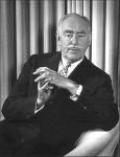Chief Justice Roger Taney made his contribution to the ideology of white supremacy when he asserted that blacks were a people apart, beyond the promise of the Declaration and the guarantees of the Constitution.
Editor's Note: H. W. Brands is a history professor at the University of Texas at Austin.
Her philosophy was embodied in the words engraved over the entrance to the Supreme Court: "Equal Justice Under Law"
The architect of American race relations in the twentieth century, he ended legal segregation in the United States and became the first African-American on the Supreme Court.
Editor's Note: Juan Williams is a journalist and political analyst for Fox News and writes for The Washington Post, The New York Times, Atlantic Monthly, and other publications.
In many ways, the Constitution as we know it results from their landmark decisions.
A half-century ago Chief Justice Earl Warren retired from the Supreme Court, marking the end of the Warren Court in 1969. In many ways, the Constitution as we know it today is the result of judgments handed down in the 16 years after President Eisenhower appointed Warren to be Chief Justice.
In many ways, the Constitution as we know it results from their landmark decisions.
A half-century ago Chief Justice Earl Warren retired from the Supreme Court, marking the end of the Warren Court in 1969. In many ways, the Constitution as we know it today is the result of judgments handed down in the 16 years after President Eisenhower appointed Warren to be Chief Justice.
Critical decisions by the Chief Justice saved the Supreme Court’s independence—and made possible its wide-ranging role today
Most jurists and constitutional scholars today would probably contend that the most controlling precedent to be set in the early republic was laid down in the 1803 Marbury v. Madison decision. While a formidable ruling, it was not, however, the decisive moment—at least not to people at the time.
A new picture of prairie lawyers coping with bad roads and worse inns on the Illinois frontier, drawn from David Davis’ letters
Neither the Constitution nor the laws but John Marshall made the Court Supreme
The strange story behind the most cited case in American history: THE MIRANDA DECISION
The strange story behind the most cited case in American history: THE MIRANDA DECISION
On the sixtieth anniversary of Pearl Harbor, the granddaughter of a Japanese detainee recalls the community he lost and the fight he waged in the Supreme Court to win back the right to earn a living
To the casual visitor, terminal island in Los Angeles Harbor is no more than a complex of dull warehouses and empty lots.
IT’S SAID THAT FLANNERY O’CONNOR WAS THE first graduate of a university writing program to stake a claim to major-writer status.
America looked good to a high school senior then, and that year looks wonderfully safe to us now, but it was a time of tumult for all that, and there were plenty of shadows along with the sunshine
It was a very good year. Certainly it was if you were seventeen. I was a senior in high school in 1954, a member of the class of January 1955, at Lincoln High School in Jersey City, New Jersey.
It has always been politics as usual
Supreme Court vacancies have provoked fierce, colorful—and wholly partisan—battles since the earliest years of the Republic
James Wilson was an important but now obscure draftsman of the Constitution. Carry Wills is a journalist and historian fascinated by what went on in the minds of our founders. The two men meet in an imaginary dialogue across the centuries.
His red judge’s robe looked faded and theatrical by daylight. People at the bus stop stared at him, and his face flushed near the color of the robe. But he busily ignored them.
In this year of the bicentennial of the Constitution, American Heritage asked a number of historians, authors, and public figures to address themselves to one or both of these questions:
The framers of the Constitution were proud of what they had done but might be astonished that their words still carry so much weight. A distinguished scholar tells us how the great charter has survived and flourished.
Oliver Wendell Holmes was wounded three times in some of the worst fighting of the Civil War. But for him, the most terrible battles were the ones he had missed.
He was born in 1841, in a Boston that took its water from backyard wells and its light from whale-oil lamps. He died ninety-four years later in a nation that the army pilot James Doolittle had just crossed in twelve hours.
When Elsie Parrish was fired, her fight for justice led to dramatic changes in the nation’s highest court.
When, on a spring day in 1935, Elsie Parrish walked into the office of an obscure lawyer in Wenatchee, Washington, to ask him to sue the town’s leading hotel for back pay, she had no idea she was linking her fate to that of exploited women in a Brooklyn laund
Dear Chief: It is coming up on twenty-five years since, fresh out of law school, I reported for duty as your clerk on the Supreme Court.
The Founding, Fathers never did agree about the proper relationship between church and state. No wonder the Supreme Court has been backing and filling on the principle ever since.
THE SUPREME COURT has been busy of late scrutinizing the “wall of separation,” a figure of speech attributed to Thomas Jefferson. It is not like the ugly Berlin Wall, built of concrete blocks and topped with broken glass and barbed wire.
A quarter-century of judicial history, as seen—and made—by our only retired Supreme Court justice, a man whose allegiance to the Constitution often forced him to act against his personal preferences.
POTTER STEWART CAME TO the Supreme Court in 1958, appointed by President Eisenhower at the age of forty-three.
Americans don’t hesitate to say anything they please about a public performance. But the right to do so wasn’t established until the Cherry Sisters sued a critic who didn’t like their appalling vaudeville act.
The year 1896 found Oscar Hammerstein in trouble. He was in debt, and the acts he had brought to Broadway weren’t doing well. He was desperate. “I’ve tried the best,” he is reported to have said. “Now I’ll try the worst.” So he sent for the Cherry Sisters.
The Supreme Court says the First Amendment gives newspapers the right to denounce the government, advocate revolution, attack public figures, and even be wrong. This may not be nice—but those who understand the strengths of a republic wouldn’t have it any other way.
During the summer of 1919 a group of dissident members of the Socialist party, including the radical journalist John Reed, published a manifesto in the left-wing newspaper Revolutionary Age attacking the party’s more moderate e
The great sit-down strike that transformed American industry
At General Motors’ Flint, Michigan, Fisher Body Number One, the largest auto-body factory in the world, it was early evening of a chill winter day.
Nobody was murdered or maimed, but nobody backed down for twenty years in the struggle over school integration in Prince Edward County, Virginia. Who finally won?
“We are a religious people.…” The United States Supreme Court likes to quote this dictum by Justice William O. Douglas, who coined the phrase to accompany a decision in 1952.
The leak was known of old. It can afflict either a ship or a government, it invariably means that something invisible has gone wrong, and in certain cases it ends in disaster.





